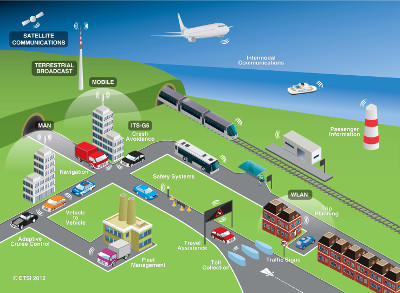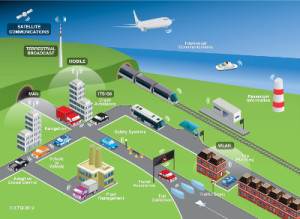Talking Cars


The automobile. If you have one, it is the largest computer you own. When you think about the rate of changes made from the Model T to the present day 4-door family sedan, the evolutionary rate of development has been extraordinary. It’s data and computers and sensors that inform what’s running right with your car, from the fuel consumption to the brakes. And it’s data and technology that continue to make cars more efficient, durable and safer.
Intelligent Transport Systems
The idea behind Intelligent Transport Systems (ITS) is to increase safety and mobility: allowing you and I to get where we need to quicker and safer. How’s this possible? One component of ITS is IEEE 802.11p, a variant of Wi-Fi, or Dedicated Short-Range Communications (DSRC). This technology is responsible for vehicle-to-vehicle and vehicle-to-infrastructure communications; basically cars can talk to each other and to buildings. An Australian company, Cohda Wireless, is at the forefront of this new frontier.
Cohda is part of a pilot project sponsored by the US Department of Transportation. The $15 million grant equips 3,000 cars with Wi-Fi based transmitters for vehicle-to-vehicle and vehicle-to-infrastructure communications. It works like this: each car is outfitted with a GPS receiver and DSRC radio, which exchanges speed and position data with other vehicles nearby. A computer integrates the vehicle-to-vehicle information with onboard data to determine how drivers respond to warnings, such as lane-change and collision avoidance. Of course, it is ultimately up to the person in the driver’s seat to react in time, and correctly, to avoid an incident.
Other Options
And if it’s incidents we want to avoid, why not just have robotic cars? Perhaps you’ll recall the Google driverless car. With over $200,000 worth of equipment in the vehicle, it’s unlikely these will be parked in family garages any time soon.
The other reason robotic cars may not catch on is for the basic fact that people love to drive. Many of us long for the open road with the wind in our face as we chase down new adventures. For many rural and small towns and suburbia, driving is a way of life. A subway system or light rail facility is either a dream or a nightmare, if it were to happen, for many municipalities.
But if you are in the big city, then public transit systems are in many ways ‘driverless’ – in that when you step on board, you don’t have to worry about the driving.
Given the number of train derailments occurring in the past few weeks (with incidents in the United States, Canada, France, and most recently, Spain), we may want to think about equipping our commuter trains with IEEE 802.11p. If this technology could identify debris on the tracks, or misaligned tracks up ahead, or signals that are not responding to its sensors, or if a train is approaching a curve with too great a speed, it could very well minimize train derailments and incidents; resulting in far fewer fatalities, property damage and disruption to transportation networks. (Note: there is GSM-R, (Global System for Mobile Communications – Railway) technology in operation in Europe, China, Africa and Australia. This technology is a voice and data communications platform reliant on humans to signal a warning.)
After 120 years on the road and over 200 years on the tracks, we still don’t have this commuting problem worked out; and it will likely never be perfect. If we utilise ITS in more projects, both on the road and the rails, we may near that safer, more mobile level of transport we all desire.
Burnes K (2013-07-30 00:20:23). Talking Cars. Australian Science. Retrieved: Nov 16, 2025, from https://ozscience.com/news/talking-cars/
 Follow
Follow